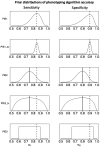PIE: A prior knowledge guided integrated likelihood estimation method for bias reduction in association studies using electronic health records data
- PMID: 29206922
- PMCID: PMC7378882
- DOI: 10.1093/jamia/ocx137
PIE: A prior knowledge guided integrated likelihood estimation method for bias reduction in association studies using electronic health records data
Abstract
Objectives: This study proposes a novel Prior knowledge guided Integrated likelihood Estimation (PIE) method to correct bias in estimations of associations due to misclassification of electronic health record (EHR)-derived binary phenotypes, and evaluates the performance of the proposed method by comparing it to 2 methods in common practice.
Methods: We conducted simulation studies and data analysis of real EHR-derived data on diabetes from Kaiser Permanente Washington to compare the estimation bias of associations using the proposed method, the method ignoring phenotyping errors, the maximum likelihood method with misspecified sensitivity and specificity, and the maximum likelihood method with correctly specified sensitivity and specificity (gold standard). The proposed method effectively leverages available information on phenotyping accuracy to construct a prior distribution for sensitivity and specificity, and incorporates this prior information through the integrated likelihood for bias reduction.
Results: Our simulation studies and real data application demonstrated that the proposed method effectively reduces the estimation bias compared to the 2 current methods. It performed almost as well as the gold standard method when the prior had highest density around true sensitivity and specificity. The analysis of EHR data from Kaiser Permanente Washington showed that the estimated associations from PIE were very close to the estimates from the gold standard method and reduced bias by 60%-100% compared to the 2 commonly used methods in current practice for EHR data.
Conclusions: This study demonstrates that the proposed method can effectively reduce estimation bias caused by imperfect phenotyping in EHR-derived data by incorporating prior information through integrated likelihood.
Keywords: association study; bias reduction; electronic health record; misclassification; prior information.
© The Author 2017. Published by Oxford University Press on behalf of the American Medical Informatics Association. All rights reserved. For Permissions, please email: journals.permissions@oup.com.
Figures




References
-
- Denny JC,Crawford DC,Ritchie MD,et al.Variants near FOXE1 are associated with hypothyroidism and other thyroid conditions: using electronic medical records for genome- and phenome-wide studies.Am J Human Genet. 2011;894:529–42. - PMC - PubMed
Grants and funding
LinkOut - more resources
Full Text Sources
Other Literature Sources

